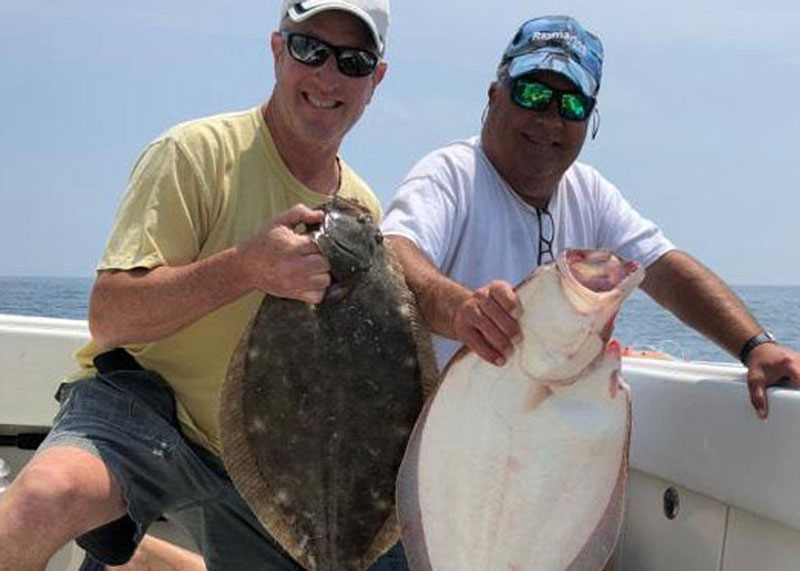Every serious flounder angler dreams of catching doormats — you know, those big trophy fish that make everyone say “wow.” And even though the occasional trophy flounder may be caught mixed in with smaller fish, big flounders tend to be attracted to specific conditions. In our area they tend to be deeper, more structure-oriented, and looking for a large meal.

Flounder on Deep Structure
I catch my share of flounder up to about 22 inches while jigging in water less than 20 feet deep. Make sure you read “Light Tackle Flounder Fishing” for catching flounder in shallow water. But if I’m looking for flounder bigger than that, I tend to go deeper. Around the lower Bay, this may be in water from 30 to 90 feet. Or it may mean fishing nearshore wrecks and offshore wrecks.
While a lot of inshore flounder are caught using light spinning tackle, I switch to a conventional reel for big fish. My favorite outfit is an Avet SXJ5 reel spooled with 30-pound braided line on a six-foot, six-inch medium-heavy rod. This is a rig with a small lever-drag reel that works well across a lot of applications.
I have done well on the occasional large flounder in several spots along the CBBT. Though it hasn’t been productive for me in the past few years, the Yancey wreck is a good place to begin. This was a barge that hit the bridge and sank a long time ago. There is still a lot of rubble right up near the bridge. The easiest way to find it is to look for a couple of sets of pilings that are closer together than other sets of pilings a few hundred yards south of the first island. Expect to get snagged a few times while working this area.
Fishing along the channel edges near either tunnel can also be productive. Of course, these days there is a lot of construction going on around the first and second islands, so it is a bit more difficult to fish there. The remains of another wreck may be found just past the second island. There isn’t as much structure here, but it has been a popular spot for serious flounder anglers for years. Moving north along the bridge, the bend just before the third island used to be a great place for flounder.
Beyond the CBBT, there are many ocean wrecks and reefs that hold nice flounder throughout much of the year. The reef near the Chesapeake Light Tower is sometimes productive. The water here is about 35 to 45 feet deep. As a bonus, you may hook into some nice sea bass while looking for flatties. Another good spot for flounder and sea bass is the Triangle Wreck/reef area. The Triangle has lots of structure spread out over a large area in about 100 feet of water. An added bonus here is that this reef area also holds tautog.
These are just a few of many productive flounder spots in the ocean. Different captains have their favorites. The key is to find a wreck or reef that hasn’t been fished out recently. Also, when looking for flounder at a wreck, allow your drift to start near the structure and go about 100 yards from the structure because sometimes the fish are in the sand away from the wreck.
Big Baits for Big Flounder
When looking for a big flounder I will do one of three things. If I decide to stay with jigs, I will use larger ones that will be able to hold bottom in deeper water, sometimes going as high as four ounces. Often, I will use two jigs in tandem with a lighter one on a dropper loop about a foot above the heavier one. The jigs are baited with either a five-inch plastic tail or a strip of cut bait no more than an inch wide and up to eight inches long.

When jigs aren’t working, it’s time to switch to an old tried and true method. This rig consists of a three-way swivel at the end of the line. On one of the other eyes of the swivel attach a three-foot to four-foot leader with a hook or lightweight jig, sweetened with a strip bait. The hook is often adorned with bucktail material or a plastic skirt. On the other eye of the swivel attach a one-foot leader with an appropriately sized sinker for the depth. Attach the sinker with a loop knot so you can change sinkers out without having to retie the knot.
The third choice for hunting trophies is to use live bait. The live bait rig is similar, but with a shorter leader and no adornments on the hook at all. I have been successful with mullet, spot, and croakers up to about eight inches long. Other small bait fish will work as well.
Setting the Hook
I find that when using jigs with plastic tails, they tend to hit the bait hard and get the hook in their mouth right away. With long pieces of cut bait, however, let them chew on it for a few seconds before setting the hook. With live bait it just depends on the size of the flounder and size of the bait. If you are using smaller baits, a big flounder won’t have any trouble getting it in its mouth. With larger baits you may need to allow a few seconds.
I read an article a few years ago by a very good jig angler. In the article he made fun of the notion of “letting the flounder eat” before setting the hook. This guy obviously never fished with long bait strips, or watched a six-pound flounder shake free beside the boat. For me, those extra few seconds has sometimes meant the difference between a nice dinner and a fish story about the one that got away.
-By Chuck Harrison